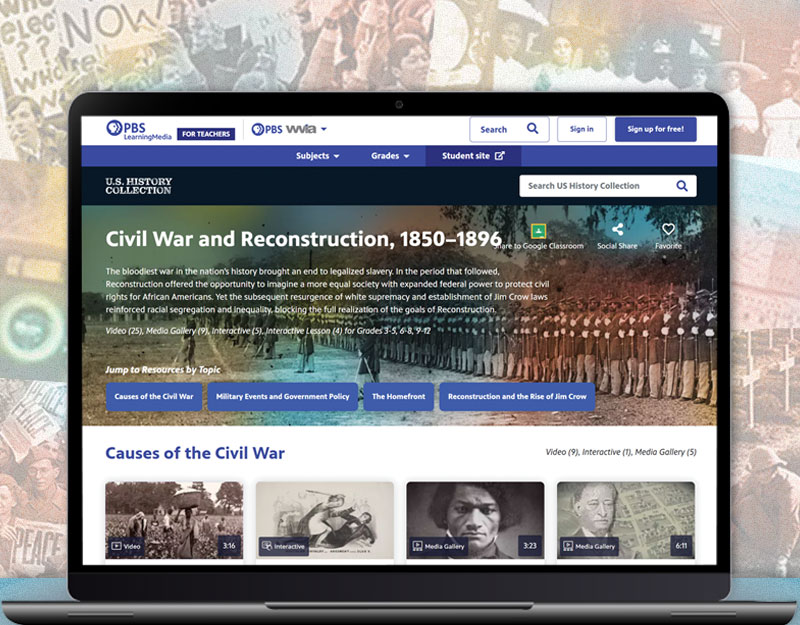SLJ Reviews the GBH and PBS Learning Media: U.S. History Collection Database
This comprehensive digital resource offers an extensive set of curated clips pertaining to U.S. History and draws from a broad archive of PBS documentaries, including many well-known series such as “The American Experience” and “American Masters.”
URL pbslearningmedia.org/collection/us-history-collection
Grade level Middle and High School
Cost Free
Content This comprehensive digital resource offers an extensive set of curated clips pertaining to U.S. History and draws from a broad archive of PBS documentaries, including many well-known series such as “The American Experience” and “American Masters.” The collection features content covering Indigenous groups, the American Revolution, and the Gilded Age, among other topics. The U.S. History Collection was developed by seasoned educators in social studies, while seeking vital student input from a diverse youth advisory group to support teaching and engaging students. The curated compilation contains 400 media-rich digital learning resources spotlighting multiple perspectives and stories that have gone untold. Video and interactive media galleries focus on primary and secondary sources, historical events, and time lines. Supplemental teacher resources are provided in the form of discussion questions, handouts, standards, and much more.
The U.S. History Collection is a website that can be accessed by any browser and is compatible with most devices. When visiting the homepage for the first time, educators can click on the Sign Up for Free button on the upper right-hand corner of the screen. Signing up is made possible by using Google, Facebook, or email credentials. Once an account is created, searching for material is simple, either by using the prominently displayed search field in the middle of the screen, which uses keywords to seek out a specific topic, or browsing through topics by “Era” or “Skill.” When users elect to browse by era, they have 16 options to choose from, which include the Revolution and Independence, The Early Republic, and The West Transformed. These are just a sampling that lend themselves well to a U.S. History classroom.
When users select an era, that time period’s landing page features a brief description and an option to narrow down to more specific content. The homepage also displays the inventory of digital resources available, as well as the grade levels that best fit the material. Digital resources vary and can include media galleries, interactive lessons, and videos. The digital resource type, the topic title, corresponding grade level, and the availability of supporting materials are clearly identified. Clicking on a topic featuring a video will navigate to the topic page. The video options of Play, Pause, 10-Second Rewind, Closed Captioning, and Full Screen are all accessible, and supplemental materials and instructional aids are found on the margins of the topic page. Users have Share options, as well as a Build a Lesson tool for teachers to structure their instructional time. To the right of the video, educators can view several resources related to the topic that are aimed for a teacher or student audience. Below the video lives a short description and a tab of the standards the content best serves. The topic page also offers the option of teacher or student view; helpful for teachers preparing for web page navigation questions.
Back at the homepage, when users select a topic by skill, they are taken to the Skills landing page. Skills include “Developing an Argument,” “Interpreting Charts and Graphs,” and “Analyzing Primary Sources.” Once a skill is selected, history topics that lend themselves well to the topic will be retrieved. The layout also contains a brief description of the skill, inventory of the digital resources, and grade levels that best correspond to the skill. Users can also browse by topic within the Skill homepage. Clicking on a topic with an interactive feature, such as a time line or image, students get to retrieve an additional layer of information. A topic page highlighting interactive features, videos, or a media gallery also includes sharing options, as well as the Build a Lesson tool, and of course, supporting materials, and standards. Users will feel at ease with the uniformity of the browsing navigation interface and topic page layouts. Supporting materials are widely available for each topic and are easy to match with Common Core or specific state standards.
Students and Teachers GBH and PBS Learning Media: U.S. History Collection is compatible with many commonly used learning management systems, such as Google Classroom. The collection has been curated to be high school and middle school focused, not as a main lesson plan, but as a supplement to curricula. The content supports students in their interpretation of history and critical thinking skills, plus encourages the building of historical empathy. The media-rich resources are easily navigable and support comprehension. Resources come in a variety of multimedia that include images, videos, interactive lessons, and primary sources, and conveniently lend themselves to a blended learning environment.
Verdict This is an appealing and extensive platform that students and educators will value for its varied collection of materials that provide suitable context to historical events discussed in a U.S. History classroom. Education institutions focused on blended learning or personalized learning approaches will appreciate this free tool. Browsing and navigation is painless and user-friendly, content is well-matched to middle and high school standards, and the supporting materials are excellent supplemental resources for educators. This would be a convenient database for any educator’s or student’s research toolbox.
Alexandra Cornejo, Harlingen School of Health Professions, TX.
RELATED
The job outlook in 2030: Librarians will be in demand
The job outlook in 2030: Librarians will be in demand
ALREADY A SUBSCRIBER? LOG IN
We are currently offering this content for free. Sign up now to activate your personal profile, where you can save articles for future viewing







Add Comment :-
Be the first reader to comment.
Comment Policy:
Comment should not be empty !!!